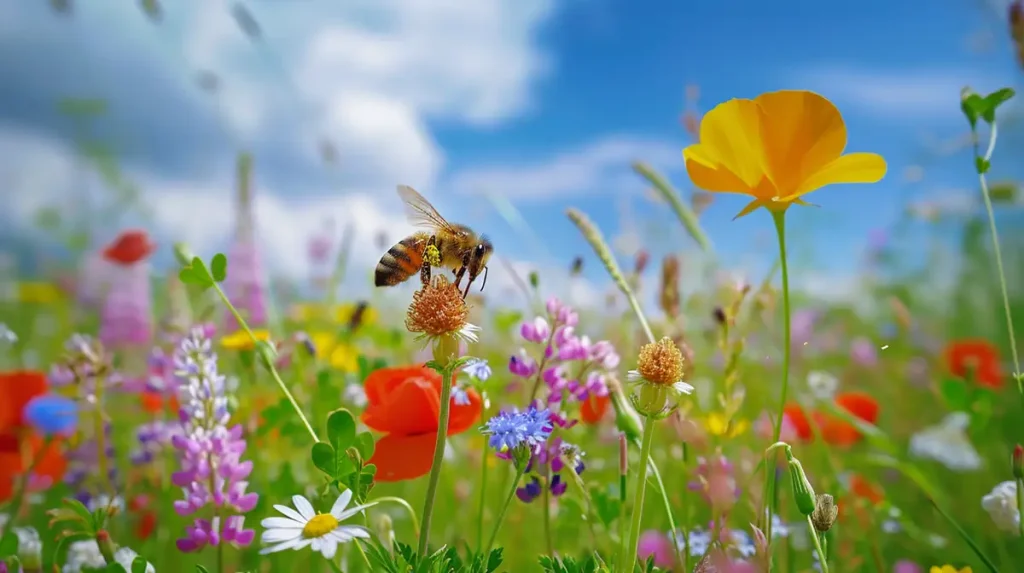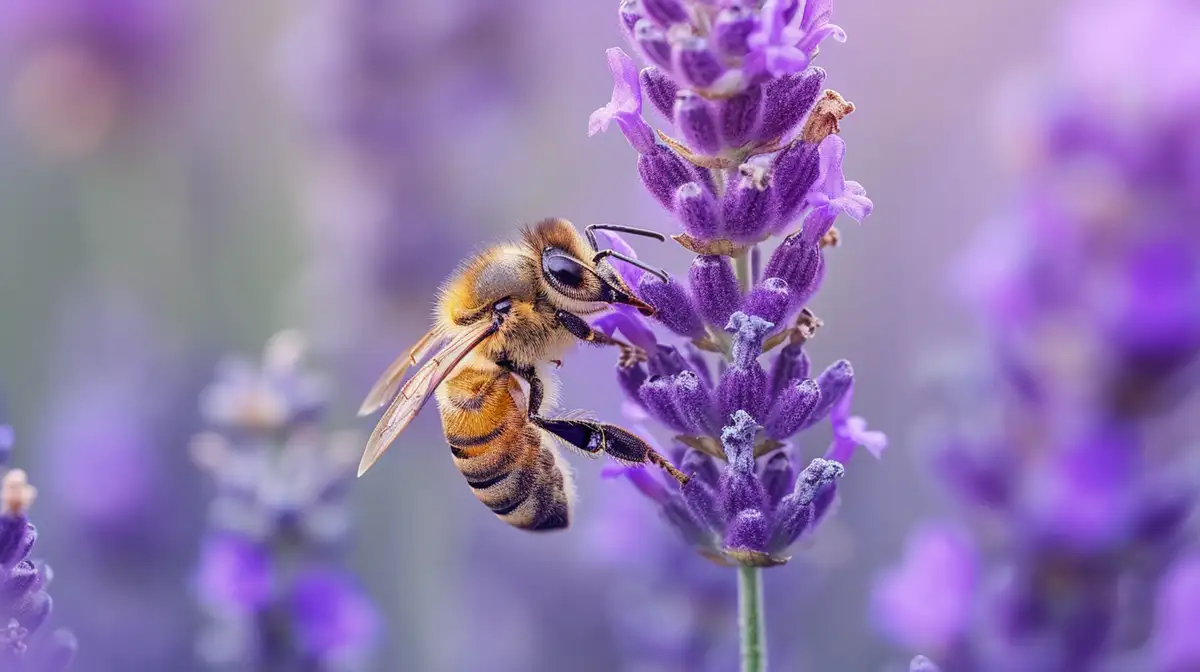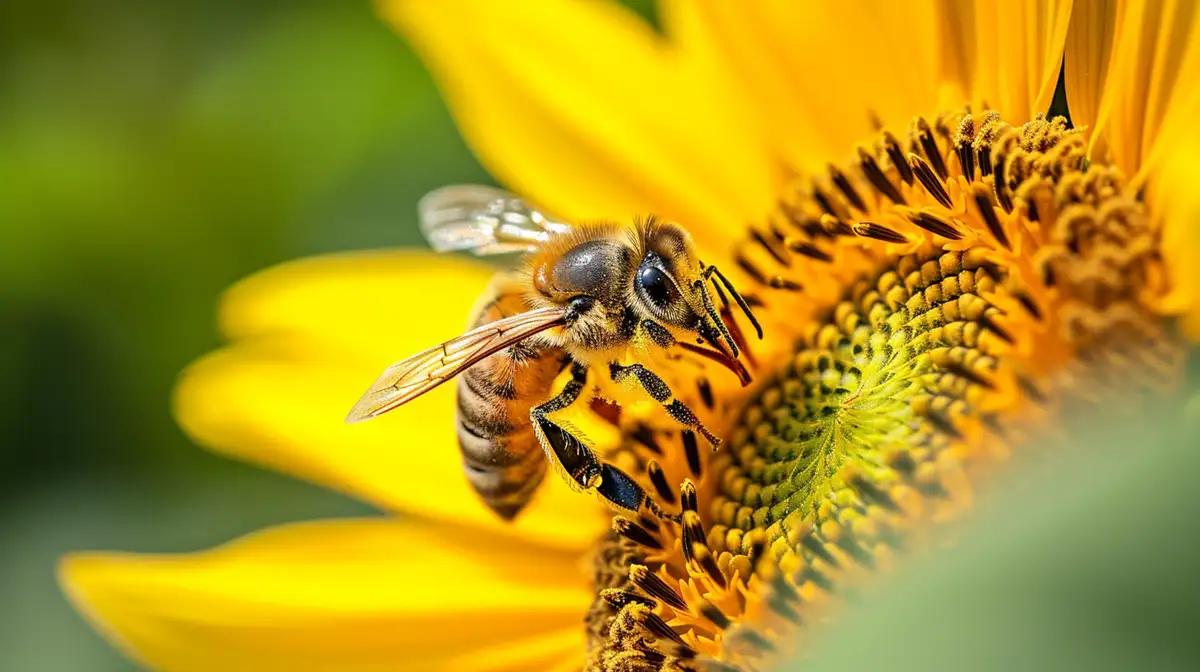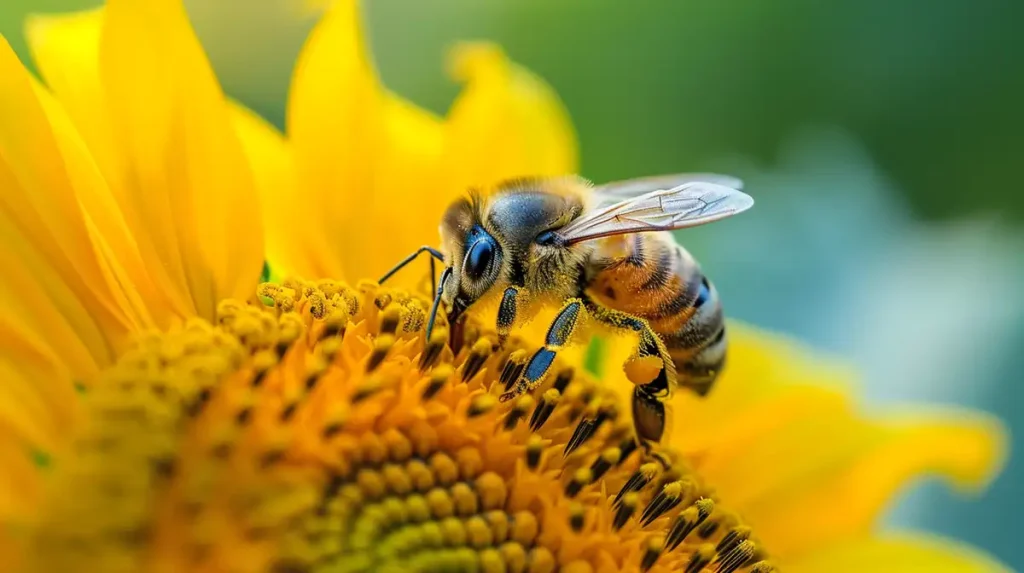Table of Contents
Bees primarily feed on nectar and pollen. Nectar, a sweet liquid produced by flowers, is a major source of energy for bees, supplying them with sugars necessary for flight and daily activities. Pollen, on the other hand, provides bees with proteins, fats, vitamins, and minerals, crucial for larval development and overall health. While adult bees consume nectar and some pollen, larvae are mainly fed pollen or a mixture of pollen and royal jelly, a special substance produced by worker bees. This diet varies slightly among different bee species and is fundamental to their survival and the health of the colony.
In the below paragraphs, we will take a more detailed look at this topic.
The issue of the dietary needs of bees is one that arises frequently, particularly among inexperienced beekeepers. It is critical to understand whether your bees will forage for their own food or if you must provide supplementary sustenance to maintain your colony’s viability.
Bees are self-sufficient and gather both nectar and pollen from flowering plants in the vicinity of their hives. Nectar is transformed into honey, which bees consume as a food source.
Pollen is a fine substance that bees gather. In addition to transferring pollen from the male to the female parts of flowers during pollination, bees also ingest this nutrient-rich substance upon returning to the hive. Pollen is abundant in sugar, protein, carbohydrates, as well as a range of minerals, vitamins, and enzymes that are essential for the honeybee’s survival.
Nectar is a fluid produced by flowers to attract insects and birds that help spread their pollen, allowing the plant to reproduce through pollination. Due to its sugar content bees are attracted to nectar, which they utilize to make honey.
The honeybee extracts nectar from flowers using its tubular mouthpart called the proboscis. After storing it in their crop or honey stomach, bees transport it to the hive. There, house bees chew the nectar to soften it and eliminate some of the water content. The house bees transfer the nectar from one mouth to another until it is completely transformed into honey. Honey is used to feed larvae and drones as well as worker bees within the hive.
What Does the Queen Bee Eat?
As the leader of the hive, the queen bee is essential to the success of the colony. Her primary role is to lay eggs, which will hatch into the worker and drone bees that are responsible for collecting nectar, pollinating plants, and protecting the hive. To fulfill this critical function, the queen requires a specialized diet that will provide her with all the necessary nutrients to maintain her health and longevity.
Contrary to popular belief, the queen bee does not eat honey. Instead, she relies on a steady supply of royal jelly to sustain her throughout her life. Royal jelly is a unique substance that is produced by young worker bees in the hive.
The production of royal jelly begins when the young worker bees secrete a milky substance from their hypopharyngeal glands. This substance is then mixed with pollen and other chemicals in the bees’ mouths to create the nutritious substance.
The Benefits of Royal Jelly
Royal jelly is a highly nutritious substance that contains a variety of vitamins and minerals, as well as all the dietary supplements required by the queen. It is packed with proteins, lipids, and carbohydrates that provide the queen with the energy she needs to lay thousands of eggs each day.
With a diet of royal jelly, the queen bee will grow to be much larger than the other bees in the hive. In fact, she can be up to twice the size of a worker bee. This increase in size allows her to lay more eggs and ensures that the colony has a steady supply of worker and drone bees to carry out their various tasks.
- Carter, Anthony (Author)
- English (Publication Language)
- 194 Pages - 02/28/2024 (Publication Date) - Independently published (Publisher)
The queen bee’s diet of royal jelly also plays a crucial role in her longevity. While worker bees may only live for a few weeks, the queen can live for up to five years. This extended lifespan is due in part to the nourishing qualities of royal jelly, which helps to keep her healthy and strong throughout her life.
Feeding the Queen Bee
In the early stages of their development, all larvae in the hive are fed royal jelly. However, after the first few days only the queen and a select few larvae that will become future queens will continue to receive this nutritious substance.
The young worker bees responsible for producing royal jelly will carefully place the substance in the cells of the comb where the queen and her chosen larvae can access it. This feeding process is crucial to the survival of the colony, as it ensures that the queen is healthy and able to lay eggs and that there is a steady supply of future queens to take her place when she eventually dies.

What Do Drone Bees Eat
Drone bees play an important role in the bee colony by assisting the queen bee in mating and ensuring the survival of the colony. However, when it comes to food, drone bees have a significantly different diet than their worker bee counterparts. While worker bees collect nectar and pollen from flowers to create honey and bee bread, drone bees do not collect food at all.
Instead, drone bees rely on the worker bees to feed them with a mixture of honey and pollen. This mixture, known as “bee milk,” is produced by the worker bees in their glands and fed to the drone bees. The bee milk provides drone bees with the nutrients they need to grow and develop, as well as to support their reproductive role in the colony. Therefore, it is essential for beekeepers to ensure that the colony has a sufficient number of worker bees to produce enough bee milk for the drone bees.
What Do Worker Bees Eat
Worker bees are a vital part of any honeybee colony, and their diet is essential to their health and productivity. They feed on a variety of substances including nectar, pollen, and honeydew.
Nectar is a sweet liquid secreted by flowers, which worker bees collect with their tongues and store in their honey stomachs. Once back at the hive, they regurgitate the nectar to other worker bees who will transform it into honey. Pollen is another important food source for worker bees, which they collect from flowers using their legs and body hairs. The pollen is then transported back to the hive, where it is used to feed the colony’s larvae and as a protein source for the adult bees.
In addition to nectar and pollen worker bees also consume honeydew, a sweet liquid produced by aphids and other insects that feed on plant sap. They also consume water, which is necessary for maintaining the humidity levels in the hive and for diluting honey when feeding it to larvae. The diet of worker bees is carefully balanced to ensure that they have the necessary nutrients to support their health and the growth of the colony.

Do You Need to Feed Your Bees?
In most cases, the honey your bees produce will be enough to feed the colony during the lean winter months when worker bees are unable to leave the hive to forage for nectar and pollen. However, if a hive is new, the colony may not be fully established and might not have had enough time to build sufficient stores for the winter. This can also happen if a beekeeper inadvertently takes too much honey from a hive and not left enough for the bees.
If you are worried that your colony of bees will not have enough honey to make it through the winter, you can provide additional food. A good way to tell whether the hive is light on honey is to try to lift the hive. If this can be done easily enough, then it may be the case that there is not enough honey inside (bearing in mind that a colony will require around sixty pounds of honey for winter survival).
What to Feed Bees
There are a number of options for when it comes to feeding your colony. The ideal food is honey, but you should never provide commercially produced honey to bees as it could contaminate the hive. The best honey to provide is that which you have previously taken from the hive. However, if you do not have this, you can make alternatives instead:
Sugar Syrup
It is easy to make sugar syrup for bees. If the syrup is to be used as a replacement for honey during the winter, mix two parts sugar with one part water. Place the mixture on a medium heat to dissolve the sugar in the water. When the sugar has completely dissolved and the syrup is clear, allow it to cool before giving it to your bees.
Fondant
Fondant is thicker than syrup and can also be used to feed bees during the winter. To make fondant for your bees, mix four parts of 2:1 sugar syrup with four parts sugar and three parts water.
Boil the water before adding your sugar syrup and sugar gradually. Continue heating the mixture until all the sugar and syrup has dissolved and the temperature has reached 238 degrees Fahrenheit.
Allow the mixture to cool and once it is warm, mix it until it lightens in color. Separate the mixture into shallow dishes and allow it to firm up. Store the fondant in airtight containers and when needed place them in the hive on the crown board.

Which Plants Do Bees Like?
Planting the right flowers is a great way to attract bees to your garden. Bees play a critical role in our ecosystem, as they are responsible for pollinating a wide range of plants, including many of the fruits and vegetables that we rely on for food. In fact, it’s estimated that bees are responsible for pollinating up to one-third of the food that we eat.
Bees are attracted to a variety of plants and flowers, but there are some specific types that they particularly enjoy. These include:
- Lavender – Lavender is a popular choice for beekeepers and gardeners alike. Its fragrant purple flowers are a favorite of bees, and the plant is also known to repel pests like mosquitoes and flies.
- Lilac – Another favorite of bees, lilac is a beautiful shrub that produces fragrant flowers in shades of purple, pink, and white. It’s also a favorite of butterflies and hummingbirds.
- Abelia – Abelia is a flowering shrub that produces fragrant pink or white flowers. It’s a great choice for attracting bees, as well as butterflies and other pollinators.
- Foxglove – Foxglove is a tall, spiky plant that produces bell-shaped flowers in shades of pink, purple, and white. It’s a favorite of bees and hummingbirds, and can add a vertical element to your garden.
- Crocus – Crocuses are some of the earliest flowers to bloom in the spring, and they’re a great source of nectar for bees that are emerging from hibernation. They come in a variety of colors, including purple, yellow, and white.
Other popular plants for attracting bees are sunflowers, coneflowers, bee balm, and marigolds. It’s a good idea to plant a variety of flowering plants that bloom at different times throughout the growing season, as this will ensure that there is always a food source available for the bees.
How Do Bees Locate Flowers?
Contrary to popular belief, bees do not rely on their sense of smell to locate flowers. Instead, they use their vision. Bees have a unique visual system that allows them to see ultraviolet light, which is invisible to humans. Many flowers have shiny patches of ultraviolet, known as nectar or bee guides, that help guide the bee to the nectar.
Bees are also attracted to bright colors, especially blue, purple, and yellow. Flowers with these colors are more likely to attract bees than those with red or white blooms. Additionally, flowers that are shaped like tubes or bells are easier for bees to access, as they allow the bee to reach the nectar more easily.
What Do Bees Eat – Conclusion
In conclusion, understanding the dietary needs of bees is essential for beekeepers to maintain the viability of their colonies. Bees are self-sufficient and gather both nectar and pollen from flowering plants in the vicinity of their hives. While honey is an essential food source for bees, the queen bee relies on a specialized diet of royal jelly to sustain her throughout her life. Providing additional food to the colony may be necessary during the winter months, and sugar syrup or fondant can be used as an alternative to honey. Planting the right flowers is also crucial for attracting bees to the garden, and a variety of flowering plants that bloom at different times throughout the growing season should be planted to ensure that there is always a food source available for the bees. By understanding the dietary needs of bees and providing them with the necessary food sources, beekeepers can ensure the health and longevity of their colonies.
FAQs
Q: Do all bees eat the same thing? A: No, different species of bees have different dietary needs. For example, some species of bees are specialized to feed on only certain types of flowers.
Q: How do bees collect nectar and pollen? A: Bees use their long tongues to collect nectar from flowers, and they use their legs to brush pollen from the flower’s stamen. The pollen sticks to the bee’s hairs and is transported back to the hive.
Q: Do bees ever eat anything besides nectar and pollen? A: Yes, some species of bees will also eat honeydew, a sweet liquid produced by some insects. Additionally, some species of bees are known to drink water and tree sap.
Q: Can bees survive on just nectar and pollen? A: Yes, nectar and pollen provide all the necessary nutrients for adult bees to survive. However, bee larvae require a more diverse diet that includes proteins and fats.
Q: Do bees need a lot of food? A: Yes, bees need to consume a lot of nectar and pollen to produce enough energy to fly and maintain their hives. A single honey bee can visit up to 100 flowers in a single trip.
Q: What happens if bees can’t find enough food? A: If bees cannot find enough food, their health and productivity will decline. In severe cases, entire hives may collapse due to starvation.
Q: What can I do to help bees find food? A: You can plant flowers that are rich in nectar and pollen, provide a water source, and avoid using pesticides and herbicides in your garden. Additionally, you can support local beekeepers by buying their honey and beeswax products.
Looking to up your beekeeping game? Check out our latest product recommendations so you can take things to the next level!
Introducing The Top 12 Best Beekeeping Veils For 2024
Introducing The Top 20 Best Beekeeping Gloves For 2024
Introducing The Absolute Best Beekeeping Suits For 2024
The 15 Top Beekeeping Books for 2024
The Top 11 Honey Extractors for 2024
The Top 12 Mason Bee Houses for 2024
Last update on 2024-04-25 / Affiliate links / Images from Amazon Product Advertising API


